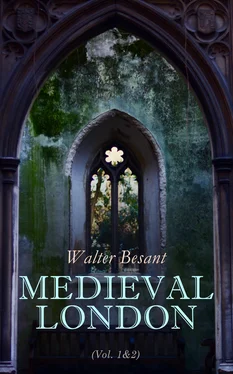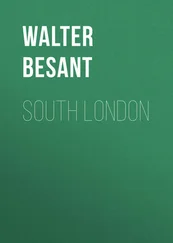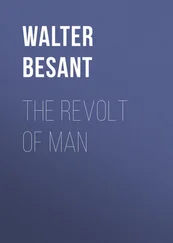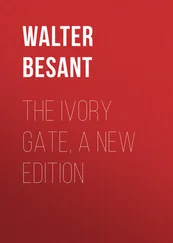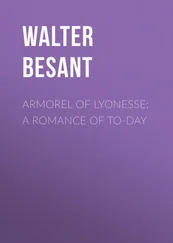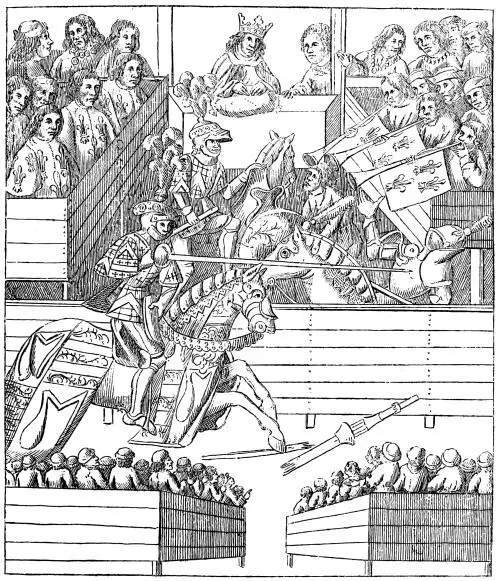
A JOUST OR TOURNAMENT OF THE PERIOD
From Strutt’s Manners and Customs.
Edward proposed, next, to remove the Staple to the Continent, but the opposition of the merchants obliged him to renounce this project. He thereupon abolished all Staples, and established Free Trade in Wool. He also invited Flemings to come over, settle in England, and carry on their weaving here.
Cheapside would seem to present a narrow and confined area for the manœuvres and the combat of mounted knights, yet King Edward held a great Tournament there in the year 1331. We must remember that between the Church of St. Peter in the west and the House of St. Thomas of Acon in the east the street was a great deal wider than it was afterwards: for a length of 750 feet east and west it had a width of something like 150 feet; the space being occupied chiefly by stalls. It narrowed on the east side at the Poultry, and on the west side at St. Peter’s Church, part of the burial ground of which still remains. Stow’s account of what happened at the Tournament is as follows:—
“In the middle of the City of London in a street called Cheape, the stone pavement being covered with sand, that the horses might not slide when they strongly set their feet to the ground, the King held a tournament three days together, with the nobility, valiant men of the realm, and other some strange knights. And to the end the beholders might with the better ease see the same, there was a wooden scaffold erected across the street, like unto a tower, wherein Queen Philippa and many other ladies, richly attired, and assembled from all parts of the realm, did stand to behold the jousts: but the higher frame, on which the ladies were placed, brake in sunder, whereby they were with some shame forced to fall down, by reason whereof the knights, and such as were underneath were grievously hurt: wherefore the Queen took great care to save the carpenters from punishment, and through her prayers (which she made upon her knees) pacified the King and Council, and thereby purchased great love of the people. After which time the King caused a shed to be strongly made of stone for himself, the Queen, and other estates to stand on, and there to behold the joustings, and other shows, at their pleasure, by the Church of St. Mary Bow, as is showed in Cordwainer Street Ward.”
The stone “selde” or shed, as Stow calls it, was still standing in his time. “Without the north side of St. Mary Bow towards West Cheap a fair building of stone called in record Seldam: a shed which greatly darkeneth the said church; for by means thereof all the windows and doors of that side are stopped up.” Henry IV. granted the place to certain Mercers who established shops there but did not pull it down or alter it, and it remained until the Great Fire as the place from which great personages witnessed City shows. The places most commonly used for tournaments were Smithfield and Tothill Fields. At the former was held a very great tournament thirty years later, in the presence of the King and Queen, and another forty years after there was another when the old King conducted thither, to grace the sports, his mistress Alice Perrers, sitting in a triumphal chariot, as the “Lady of the Sun.”
The example in anarchy and disorder witnessed during the last reign makes it less surprising to hear of fresh riots in London, apparently among the Craftsmen. The King addressed a strong letter to the Mayor calling upon the City to repress these disorders. Further measures were taken against disorderly folk in the City but without success, since the King was forced to write again upon the subject. On Wednesday, 12th April, Sir Robert de Asheby, Clerk of the King, summoned the Mayor and Aldermen before the King’s Council at Westminster. Here they were informed that the King was going to war; that this was a costly amusement; and that he desired the City to lend him £20,000. The Mayor begged for time, and called a meeting of the Aldermen and the better sort, not at Guildhall, but at the Chapter House of Westminster. They began by offering the King 5000 marks, which is £3333: 6: 8. This the King refused, with an intimation that if they could do no better than that, he should ask for a list of the principal citizens. They therefore held another meeting and offered to lend the King £5000—“although it was a hard thing and difficult to do.” This offer was accepted. To raise this sum the whole of the City was assessed, sparing none. The richest man in the City was William de Caustom, Alderman, who was assessed at £400; that is to say, his share of the loan was set down at £400.
In 1338 there was a scare about a French descent. The King ordered the City to be “strictly closed” and fortified against any sudden attack by water. Everybody was to aid in this work, whether belonging to a religious community or not.
An inventory of munitions of war was drawn up in 1339. It shows that at a house near the Tower called the “Bretasche” there were 7 springalds (large crossbows); 380 quarels or bolts feathered with leatten or latone (a mixed metal); 500 quarels of wood; 29 cords; and 8 bows of ash for the springalds. At Aldgate 1 springald and 40 quarels; in the Chamber of the Guildhall 6 engines of latone usually called “gonnes” and 5 rollers for the same; also pellets of lead weighing 4½ cwt.; and 32 pounds of powder. This is the earliest mention of guns in England, the next earliest occurring five years later. Riley suggests that they had been brought over to this country by the Bardi from Florence whose guns had been used in war as early as 1326. He quotes Chaucer, House of Fame, book iii.:
“Swift as a pellet out of a gonne
When fire is in the powder ronne.”
The King and the citizens were on friendly terms throughout: but from time to time we see a touch of the Plantagenet.
The assessment shows the comparative wealth of the various wards:
|
£ |
s. |
d. |
| Tower Ward |
365 |
0 |
0 |
| Billingsgate Ward |
763 |
0 |
0 |
| Bridge Ward |
765 |
6 |
8 |
| Dowgate Ward |
660 |
10 |
0 |
| Langburn Ward |
352 |
6 |
8 |
| Wallbrook |
911 |
0 |
0 |
| Bishopsgate Ward |
559 |
6 |
8 |
| Limestreet Ward |
110 |
0 |
0 |
| Cornhill Ward |
315 |
0 |
0 |
| Cheap Ward |
517 |
10 |
0 |
| Broadstreet Ward |
588 |
0 |
0 |
| Vintry Ward |
634 |
16 |
8 |
| Bread Street Ward |
461 |
16 |
8 |
| Queenhithe Ward |
435 |
13 |
4 |
| Cordwainer Street Ward |
2195 |
3 |
4 |
| Faringdon Ward Within |
730 |
16 |
8 |
| Faringdon Ward Without |
114 |
13 |
4 |
| Cripplegate Ward |
462 |
10 |
0 |
| Colemanstreet Ward |
1051 |
16 |
8 |
| Candlewickstreet Ward |
133 |
6 |
8 |
| Aldgate Ward |
30 |
0 |
0 |
| Portsoken Ward |
27 |
10 |
0 |
| Castle Baynard Ward |
63 |
6 |
8 |
| Bassisshaw Ward |
79 |
13 |
4 |
| Aldersgate Ward |
57 |
10 |
0 |
| Sum Total |
£12,385 |
13 |
4 |
A riot in the streets between the Fishmongers and the Skinners led to results much more useful than a King’s letter, for two rioters were executed—an example greatly needed and extremely useful.
Читать дальше
